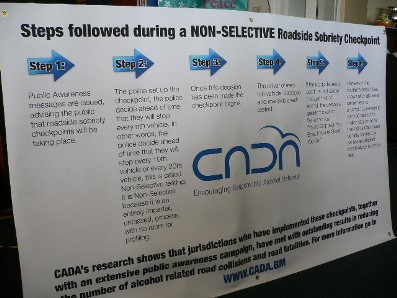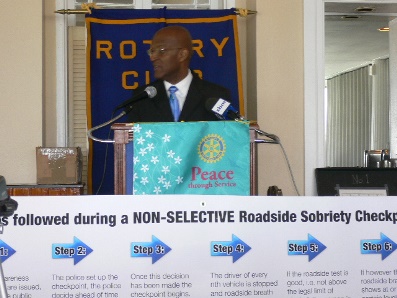Speech to Rotarians Sobriety Checkpoints
Speech to Rotarians Sobriety Checkpoints


CADA Chairman, Anthony Santucci, today gave the following remarks to Hamilton Rotarians on the topics of Educating the Community about Sobriety Checkpoints, what they look like and what they are designed to do.
AND.
Encouraging Open Dialogue between Adults and Young People about not drinking alcohol until at least age 18 and about responsible drinking after age 18 —
“Good afternoon President Simons, Rotary members, ladies and gentlemen. It is always a pleasure to speak at Hamilton Rotary lunches each April. As you know, April is Alcohol Awareness Month. At CADA, encouraging responsible alcohol behavior, we host a number of activities each year to increase the public’s awareness of what responsible alcohol consumption looks like.
This year, we have two goals for the month. They are to educate the community about sobriety checkpoints, what they look like and what they are designed to do. Our second objective is to encourage open dialogue between adults and young people and children about not drinking alcohol until at least the age of 18 years and about responsible drinking after age 18 years.
The Department for National Drug Control recently issued the results of a study they conducted amongst students in P5, P6 and M1. Students in 34 public, private and home schools participated. The report indicates that the number of children who use alcohol and drugs tends to increase as they get older. For instance 33% of 12 year olds reported using alcohol compared to 17% of 10 year olds. he DNDC report highlights what we at CADA believe every parent, grandparent and guardian should know about young people and the use of alcohol and drugs. The following statements are taken directly from the report.
Youths who drink are also more likely to be victims of violent crime and sexual assault. They are more likely to have serious problems in school, be involved in drinking-related traffic crashes, and develop problems with alcohol later in life.
To this end, CADA has developed a number of techniques to help parents as they work with their children and young people to ensure they understand the importance of not trying alcohol before the age of 18 years. The role of speaking with children within our sphere of influence about alcohol falls on the shoulders of all responsible adults. It is often a difficult topic to broach and we recommend that several talks take place, not just one big talk. Expect these types of tough questions and more. However don’t shy away from the discussion because you may have to answer these types of questions. This is even more reason to hold the conversation and to encourage an open and honest dialogue about a serious issue that if not prevented could have lasting health implications on the child.
Throughout the month, you will hear me and my fellow board members talk about Sobriety Check Points. We are advocates for this program as we know that in jurisdictions where it has been implemented there has been a significant decrease in the number of alcohol related road collisions and road fatalities. I’m sure, like me, you were stunned by the number of road traffic fatalities that occurred at the start of this year. While we don’t know what caused these road tragedies, I can tell you generally speaking that a large number of the deaths which occur on Bermuda’s roads involve alcohol and or drugs. We believe the introduction of Sobriety Check Points will go a long way to reducing, and perhaps eliminating, the number of fatalities on our roads.
What are Sobriety Check Points and how do they work? As an organization, CADA has looked at best practices and found that countries such as Ireland, Australia and all European Union countries with the exception of the UK, have now adopted the practice of:
• setting up well publicized roadside checkpoints;
• stopping every nth vehicle;
• having every motorist that is stopped do a roadside alcohol breath test.
If the roadside breath test shows the person at or above a certain level of alcohol, he or she is then transported to the Police Station or to the Police Command Vehicle for the fully calibrated alcohol breathalyzer machine test.
If the fully calibrated machine shows the person’s alcohol level is above the legal limit for driving the person is arrested for impaired driving.
The true objective of this practice is to create awareness amongst motorists that if they drink and then drive, apprehension is inevitable. In order for this to be effective the enforcement and prevention campaign must be:
• highly visible;
• conducted as often as possible;
• rigorously enforced so as to ensure credibility; and
• well publicized.
For this initiative to be successful in Bermuda, the Bermuda Government and Bermuda Police Service, would have to support the program as they would have to administer it. For Alcohol Awareness Month, we created fliers to share with the public on how Sobriety Check Points would work in Bermuda. I bought some of the fliers to share with you.
As you see the program starts with a well publicized awareness campaign, letting motorists know when the Sobriety Check Point will be set up, for example, on a Friday night at 2:30am.
The police will set up the check point and decide beforehand that they will stop every nth car. They can decide to stop every 10th car or every 20th car. Whatever their decision is, each car that falls onto that number will be stopped. This is called non-selective testing because it is an entirely unbiased process with no room for profiling.
Once the check point is set up the driver of every nth vehicle is stopped and the roadside breath test is administered. If the motorist is not over the legal limit of alcohol, within a few minutes they are free to continue on their journey. We like to say: “You’re Stopped, You Blow, If You’re Good, You Go.” If however the roadside breath test shows at or above a certain level of alcohol, the person is transported to the Police Station or to the Police Command Vehicle for the fully calibrated alcohol breathalyzer machine test.
We see this as a simple 6-step process that saves lives. CADA will continue to lobby for this life-saving initiative as it will ensure fewer people are killed on our roads and Bermuda’s roads will become safer for all of us. We are a very small community. When one person loses their life in a road traffic crash, we are all impacted. Equally, if someone suffers extensive injuries that may have long-lasting physical, mental and emotional ramifications, we are all affected. In each case, we have lost the knowledge, wisdom and contribution that person would otherwise have made to our society.
CADA’s ABCD awareness campaign helps to remind people that they should put a plan in place before they leave home, if they intend to drink. The ABCD campaign has been in place for a number of years and is extremely simple in its message. Always use a Bus, Cab or Designated Driver. This simple reminder saves lives. As individuals we must continuously remind each other and demonstrate responsible alcohol behavior. If you and friends get together for dinner and drinks make sure you have a plan in place to get home safely. Your responsibility is to remind others beforehand to put their plan in place.
Ladies and gentlemen, I encourage you to visit our website – cada.bm – to learn more about both areas of focus for Alcohol Awareness Month. Talking to children and young people about not drinking alcohol before the age of 18 and Sobriety Check Points. As we continue our education and advocacy to save lives, we encourage you to join us. Make copies of your fliers and share them with others. Tell at least two people about my talk today. Encourage three others to visit our website. Demonstrate to four people the importance of Always use a Bus Cab or Designated Driver. You have a voice and we urge you to use it. You can help to save a life.
Thank you.
